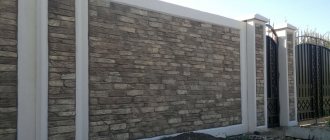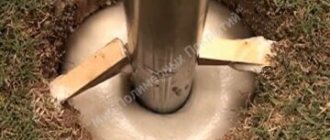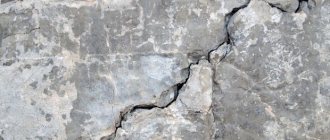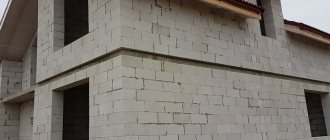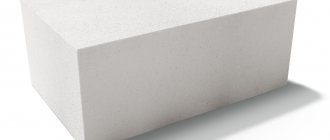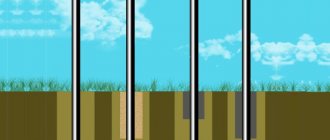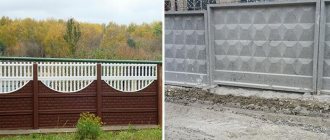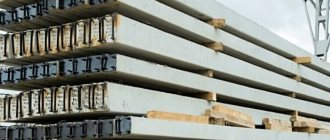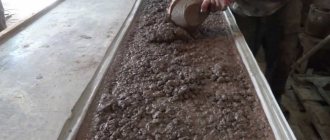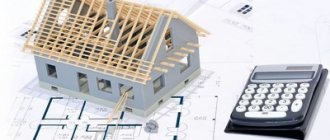A modern concrete fence has high performance qualities and can satisfy the most demanding needs. Such fencing has a wide range of applications; they amaze with their diversity not only in design, but also in appearance. It is customary to distinguish the following types of concrete fences:
- monolithic self-standing fencing;
- decorative one- and two-sided concrete fences;
- typesetting with the possibility of final decorative finishing;
- combined.
A self-standing fence is made from monolithic sections; it is distinguished by its laconic design, reliability and durability. Individual blocks are heavy, their dimensions depend on the installation location. Installation requires a pre-prepared foundation; fencing is usually used for production areas, warehouses, parking lots, and country houses.
A decorative fence can be one- or two-sided; it has a wide variety of shapes and designs; it is usually made up of separate small sections that can be mounted without a special foundation. The textured surface of the concrete section can imitate brick, natural stone or wood. Fences of this type are used for private homes, public buildings, and schools.
After installation, stacked sections reinforced with steel rods can be painted in any color or any type of tile can be used for finishing, which makes the fence more attractive.
Composite fencing typically combines concrete and wrought iron elements to create a custom design. Most often, such fences are used for country houses, giving the site a solid appearance and harmonizing with the landscape design.
self-sufficient
decorative
combined
Types of concrete fences also include the following groups:
- solid sections, can be of greater height, are usually used for areas where maximum protection from visibility from the street is required;
- decorative openwork and partially openwork designs, excellent for country houses, have decorative permeable inserts that provide ventilation of the area and partial visibility.
Advantages of the design
A reliable and attractive fence made of concrete sections has many advantages, including:
- Weather resistance . Structures in the form of concrete sections are resistant to frost, precipitation, sudden temperature changes, and high humidity. The appearance and condition of the fence are not affected by factors such as frequent rains, snow loads, salty sea air or fogs. Such fences can be safely used in regions with a high degree of air pollution, in climatically unfavorable areas, for example, in the north.
- Durability . The estimated service life is 40-50 years, but with proper care the fence will last much longer without requiring repair or replacement. The use of vibration casting during the manufacture of sections makes it possible to remove air from the mixture as much as possible. This ensures increased density of the structure, increasing its frost resistance and stability in high humidity. Such fencing is guaranteed to withstand up to 350 freeze-thaw cycles, but only if all the conditions of the section manufacturing technology are met.
- High strength . During the manufacture of sections, reinforcement is used using smooth or corrugated steel rods. This makes it possible to increase resistance to mechanical loads and increase the durability of the structure.
- Mobility . The structure is collapsible; if necessary, it can be removed and moved to a new location, for example, when expanding the site.
- Enhanced aesthetics . The peculiarity of manufacturing sections allows you to produce sections of any size and shape, simulating the surface of stone, brick, wood. Adding pigments to the solution allows you to give the fence an individual, very attractive appearance.
- Quick installation . This type of fencing is installed very quickly; when using small sections, the use of heavy construction equipment is not required.
- Geometry of sizes . The use of special shapes in the production of sections ensures the stability of the geometric dimensions of each element. This makes it possible to quickly and efficiently perform installation using standard supports with grooves.
Advantages of Eurofences
★ Durability and reliability Euro fences are made of high-quality concrete with metal reinforcement and will serve you for many years.
★ Cost-effective Eurofences are a less expensive solution in the long term. The fact is that wood or corrugated board will require timely replacement after some time, not to mention the high maintenance needs to maintain the appearance, for example, of a bush fence. Taking into account any maintenance, the cost of the fence increases from the original cost. So prices for reinforced concrete fences will be higher at the time of purchase, but cheaper in the long term.
★ Easy to install Eurofences, unlike brick and stone fences, are installed on any soil and do not require laying a foundation. They can also be installed on surfaces that have a significant horizontal slope.
★ Speed of installation Installation of prefabricated decorative concrete fences is much faster than the construction of any other permanent fence.
★ Diversity of design The modular principle of Euro fences allows the customer to combine type-setting slabs to their liking, set the height and shape of the fence, select the texture and color of concrete slabs, and include elements from other materials into the design: natural stone, brick, metal and wood.
★ Aesthetic properties Decorative concrete fences are very beautiful, a large selection of models of stacked slabs with different surface textures and a wide range of colors allows you to create a unique individual type of fencing that can satisfy the most demanding customer.
By ordering the construction of decorative concrete fencing in, you will receive a reliable and aesthetically attractive new generation fencing at affordable prices and in a short time.
Creating fence components
The design of sectional concrete includes:
- sections of different shapes and sizes;
- support posts (it is recommended to use special supports with grooves to facilitate installation);
- foundation (depending on the characteristics of the fence, it can be strip or point for supports);
- gate and wicket.
During installation, the foundation is laid first and the supports are installed. Sections can be purchased ready-made or made yourself. But this will require special equipment and materials, and some work skills.
Stages of installation of a concrete sectional fence
Installation of a concrete sectional fence usually requires preliminary preparation of the base in the form of a shallowly buried strip. To do this, it is necessary to mark the perimeter of the site, dig a trench with a sand cushion and formwork. Next, the supporting elements are installed and the concrete mixture is poured. Since the dimensions of a monolithic reinforced concrete fence slab are quite large, installation may require a crane or other equipment that will help install each section strictly in place.
marking
sand cushion
formwork
Installation of a decorative fence with small sections can be carried out without the use of construction equipment. But it is recommended to involve 3-4 people in the work to install supports and sections. If large sections will be used during installation, a crane may be required for the work.
The installation process of sectional fencing includes the following steps:
- the territory is marked around the perimeter (the distance between the supports should be about 2 meters);
- foundation work is being carried out;
- support pillars are mounted, for which it is recommended to use a building level to check verticality;
- Concrete slabs are fastened into place, after which final decorative work is carried out if necessary
- To install gates and wickets, separate posts are mounted to which metal inserts for the doors are welded.
Advantages and disadvantages
Monolithic fencing structures have a number of advantages. Among them are:
- Strength, reliability and durability. Most sectional concrete fences have a foundation that contributes to the stability of the structure. Concrete is not subject to shrinkage, deformation processes, corrosion, is fireproof, waterproof and is not afraid of temperature changes.
- The ability to hide the territory from prying eyes. The height of some fences is more than 4 m. It can be adjusted before the construction of the structure;
- Possibility of choice. A wide range of products involves different design options. A very large number of slabs have an original appearance and look great. A variety of colors, patterns and textures are offered. The most popular are reproductions of waves, torn stone, pyramids and semicircles.
- Easy installation. Installation and fastening of concrete sections does not require special skills. They are easily inserted into the grooves of the support posts. The weight of one panel can vary from 60 to 90 kg. To cope with the work, it is enough to involve 2 - 3 people. It is quite possible to install a fence around a private building in a week.
- Versatility. Any soil is suitable for a concrete structure.
- Ease of use. Fences do not require maintenance. They do not need to be painted, washed or repaired. It is extremely rare to dismantle damaged areas.
The disadvantages of installing a concrete fence include its high cost. However, on the other hand, the operational characteristics of the design make it possible not to change it for decades. The second significant drawback of the fence is insufficient visibility.
The owners will be able to monitor what is happening behind the fence only with the help of CCTV cameras.
Tools for work
To install a concrete fence, you will need the following materials and equipment:
- Portland cement M400-500;
- sifted river sand;
- crushed stone;
- pure water;
- pigment (if sections of a certain shade are required);
- silicone or plastic molds for pouring;
- machine oil for lubricating molds;
- vibrating table;
- electric concrete mixer;
- shovel;
- pegs for marking;
- building level, plumb line;
- ready-made supports with grooves.
If one section is heavy, lifting equipment will be required, but usually a sectional fence can be installed by 3-4 people.
Areas of application
Concrete fences allow you to hide the territory from prying eyes and prevent unauthorized entry by unauthorized persons and animals. The fence adorns the landscape design and is a decorative element. Sectional concrete fences are most often produced for:
- country houses and dachas;
- private enterprises;
- plants, factories;
- military facilities;
- offices, commercial representative offices;
- large warehouses;
- hospitals;
- kindergartens and educational institutions;
- sports schools;
- banks.
In many cases, in addition to practicality, the type of panels matters.
Calculation of the number of sections
When planning the installation of a concrete fence, it is necessary to pay great attention to calculating the size of one section and the total number of elements. The standard dimensions of one section of the fence are 2 meters wide and 1.5-2 meters high. When calculating the number of sections. It must be taken into account that the total length of the section is 2.06 meters (2 meters is the working width), to this value it is necessary to add the cross-section of the support column and the presence of technological gaps.
When making calculations, the perimeter of the fence is first calculated, and the width of the gate and supports for the doors is subtracted from the resulting value. Next, the number of supports is calculated, and two pillars are dug in at once in the corner parts of the fence, that is, their cross-section is doubled. The remaining value is divided by the total width of one section, allowing you to obtain the number of slabs for installation.
Prices for concrete fences
| Photo | Name | Height, m | Length, m | price, rub. |
| Concrete slab B1 | 0,5 | 2 | 750 | |
| Concrete slab B2 | 0,5 | 2 | 750 | |
| Concrete slab B3 | 0,5 | 2 | 750 | |
| Concrete slab B4 | 0,5 | 2 | 750 | |
| Concrete slab B5 | 0,5 | 2 | 750 | |
| Concrete slab B6 | 0,5 | 2 | 750 | |
| Concrete slab B7 | 0,5 | 2 | 750 | |
| Concrete slab B8 | 0,5 | 2 | 750 |
Solutions for concrete fence
One of the most important steps in the manufacture of concrete sections is the correct choice of solution and its proportions. It is on this that parameters such as strength, durability of the structure, and resistance to loads will depend.
The basis of the solution is cement; experts recommend taking M400 or M500, which have the necessary qualities. Screened river sand without clay inclusions is used as filler. Before mixing, it is recommended to sift the sand mixture again.
When choosing the proportion of the solution, you need to focus on the brand of concrete; among the recommended proportions are the following:
- Portland cement M400 B30 is used for mixing. The proportion of the solution is 1:1.2:2.7 (cement, sand mixture and granite crushed stone, respectively). The volumetric composition for 10 liters of cement will be 11 liters of sand and 22 liters of crushed stone. The yield of concrete per 10 liters of cement will be 31 liters of finished solution.
- When using Portland cement M450, the following proportion is observed: 1:1.1:2.5 (cement, sand, crushed stone, respectively). The volumetric composition is 10: 22 (sand mixture to crushed stone), the amount of the finished solution will be 29 liters per 10 liters of dry cement.
An electric concrete mixer is used to mix the solution (a manual one may not produce the required quality). Water is added gradually, the finished consistency should resemble thick sour cream.
If you want to obtain colored sections, then special pigments are added to the solution during mixing. Their quantity is indicated by the manufacturer, the substances themselves are distinguished by rich shades, they do not fade in the bright sun, and do not wash out. Such a fence does not require additional painting after installation.
Video: proportions and composition of concrete
Reinforced concrete fences
Reinforced concrete fences are high-strength structures that are used for the construction of fences of various sizes and lengths. Fences allow you to mark the boundaries of the territory of objects for various purposes and protect this territory from unauthorized entry by unauthorized persons and intruders. Fences and barriers made of reinforced concrete are also used to protect objects from extraneous noise from the outside and the penetration of dirt into or out of the territory.
Reinforced concrete fences are used in most types of construction. Industrial, industrial, civil and, in particular, residential construction widely use high-strength fences as fencing for a wide variety of objects and surrounding areas. In addition to concrete and reinforced concrete, building materials such as wood, metal or brick are also used as fences. The choice of material, as a rule, depends on the purpose of the fencing and climatic conditions in the area where the facility is being constructed. However, practice shows that wooden fences are short-lived, brick is a fairly expensive material, and metal is susceptible to corrosion. Therefore, today reinforced concrete fences have become most popular.
Reinforced concrete has significant advantages over other building materials. The high strength of steel-reinforced concrete allows reinforced concrete fences and barriers to be subjected to significant and constant loads. Reinforced concrete fences easily resist corrosion, climate change and sudden temperature changes, from +35°C to -55°C. The high strength and water resistance of concrete make it possible to install fences directly into the ground. All these characteristics lead to the main advantage of reinforced concrete products - durability: fences and fencing elements made of reinforced concrete can last up to 50-70 years, or even more, while their original properties are maintained throughout their operation.
Another important advantage of reinforced concrete products is the relatively low price of concrete raw materials, which allows significant budget savings, not only for large companies, but also for individuals, for example, when building a private house and landscaping an adjacent plot of land. Reinforced concrete products are easy to install and do not require constant maintenance or treatment of external surfaces. Thus, the use of reinforced concrete in any area of construction is beneficial in all respects: high-quality reinforced concrete products make it possible to erect truly reliable structures, buildings and structures that will last for a long time without requiring constant repairs.
Precast concrete fences consist of the following prefabricated elements:
- panels for fences (fence slabs) - smooth or corrugated slabs with a diamond-shaped pattern. The bases of the slabs are flat or have projections that are inserted into special glass-type foundations. The use of foundations in the construction of fences allows you to evenly distribute the loads that fall on individual sections of the fence;
- plinth panels - allow you to eliminate openings that form under the main fence panels. The use of base fencing panels makes it possible to completely eliminate the visibility of territories and the penetration of small animals into these territories;
- self-standing fences (self-standing elements of fences) - special high-strength slabs having a T-shape. Self-standing fences do not require the installation of foundations and soil preparation - they can be installed directly on the surface;
- fence posts - auxiliary elements that are used as connecting and supporting elements in the construction of fences and fences made of wood, metal or reinforced concrete;
- foundations for fences (glass foundations) - are used in all cases where it is necessary to provide additional protection of fences from collapse, for example, in unstable, moving soils or when operating prefabricated fencing structures in harsh climatic conditions, characterized by frequent changes in weather and the presence of wind loads.
Reinforced concrete fences and fencing elements are manufactured in accordance with series 3.017-1 “Fencing sites and areas of enterprises, buildings and structures”, issue 1 “Reinforced concrete elements of fences”, 3.017-3 “Fencing sites and areas of enterprises, buildings and structures”, issue 1 “ Reinforced concrete elements of fences", IZH 31-77 "Prefabricated reinforced concrete fences with a height of 1.2; 2 and 2.25 m" and AE-01-07 "Fencing areas of industrial enterprises, warehouses and transport buildings and structures." Fence elements can also be manufactured in accordance with technical specifications, which are developed individually at the manufacturer together with the design organization.
Heavy concrete is used as a material for the manufacture of reinforced concrete fences and fencing elements, the compressive strength class of which is taken from B15 and higher. The frost resistance class of concrete is taken from F100 and higher, depending on the climatic conditions in the construction area. The waterproof class of concrete is W4 and higher. To provide additional protection for fences from the destructive effects of moisture, various air-entraining and water-repellent additives are added to the concrete mixture.
Fences and fencing elements are reinforced with welded mesh, which are assembled into three-dimensional frames. The following types and classes of steel are used as reinforcement material: hot-rolled steel of periodic profile of classes A-I, A-II and A-III; cold-drawn wire of class BP-I. For ease of installation, lifting hinges are made of hot-rolled smooth reinforcing steel of class A-I grade Vs3ps2, embedded elements of products are made of rolled steel grade Vst3kp2 or S235.
Reinforced concrete fences are marked with an alphanumeric designation, where the letter index indicates the name of the product. Before the name of the product, its standard size may be indicated. The number following the letter characterizes the product in appearance, size and reinforcement (a series of numbers indicates the overall dimensions of the element in decimeters). The letter after the number characterizes whether the element belongs to a fence of a certain height: A – corresponds to a fence with a height of 1.2 m, B – 1.6 m, C – 2 m. An additional index K is indicated if the element is placed on a slope.
You can not only order reinforced concrete fences, but also consult with our specialists and select the required designs of reinforced concrete products. In our sales department you can find out and clarify the price of reinforced concrete fences in advance and calculate the total cost of the order. You can buy reinforced concrete fences and fencing elements and consult on general issues of purchase and delivery by calling: St. Petersburg , Moscow , Krasnodar: (861) 279-36-00 . Company operating hours: Mon-Fri from 9-00 to 18-00. carries out delivery of reinforced concrete fences throughout Russia directly to the customer’s site or to the construction site, if infrastructure allows.
For questions regarding the installation of reinforced concrete fences and fencing elements, please contact us by phone.
The process of pouring concrete mixture into a finished mold
After mixing, the concrete mixture is carefully poured into molds. For the manufacture of sections, two methods are used - instant formwork and exposure. Both are based on vibration casting, that is, it is necessary to use a vibrating table and special molds.
The mixture is poured into fiberglass molds and placed on a vibrating table to compact the solution. In the first case, the form is removed immediately after the concrete compaction process is completed. In the second case, the solution remains in the formwork used until it gains strength.
To make the fencing sections more reliable and resistant to mechanical and other loads, it is recommended to use smooth or corrugated metal rods. Reinforcement is performed at the pouring stage; such a simple technology allows you to correctly distribute the loads on the fence sections and increase their resistance to external loads.
When choosing a production method, the operating features of the fence are taken into account. Products made using the exposure method are distinguished by greater strength, complete absence of defects and improved aesthetics. Products made using the instant formwork method are used for industrial areas, warehouses, and car parks. They do not have such high aesthetics; minor defects are possible on their surface. But the performance characteristics remain just as high.
Pros and cons of a precast concrete fence
To fully evaluate and make a decision on a specific type of future fencing, it is worth familiarizing yourself with the advantages of a prefabricated concrete fence:
- A high degree of strength, which is realized due to reinforcement structures and the strength properties of concrete. As a result, good load-bearing capacity and the ability to withstand mechanical stress are formed.
- Weather resistance, which is ensured due to the absence of air spaces with decent material density. For this reason, objects are resistant to temperature changes (frost-resistant), moisture, corrosion and chemical compounds.
- The simplicity and ease of installation for a prefabricated concrete fence is obvious due to the number of mounted elements and the methods of connecting them to each other. Moreover, due to the acceptable weight of the sections, installation can be carried out completely independently, without outside help from specialists from the construction field.
- Attractive appearance due to numerous decorative options. Imitations of natural stone, wood, and stucco can transform a concrete base and create a designer product with a unique decor.
- Reliability and long service life are ensured by the above-listed features of the material.
- Prefabricated concrete fences are easy to dismantle and can be transported without any additional problems.
- Installation is possible on any type of soil; the main factor here will be its characteristics, on which the subtype of the future foundation will be based.
- Despite the presence of sections, there are no visible gaps between the panels.
- Simple care that does not require unnecessary actions. Occasionally, if desired, it can be treated with water repellents. But in fact, during the entire operation of the structure, no maintenance is usually required.
View this post on Instagram
Publication from PREMIUM Class Fences (@wall_stone_rus) May 12, 2020 at 4:25 PDT
But a stacked concrete fence has a number of disadvantages:
- If the fence is made at a high height, then it can harm the plant crops planted nearby, casting a shadow and depriving them of sunlight. In this case, it is important to use openwork textures.
- Compared to other materials, concrete is still considered quite heavy, which indicates the need for a more careful approach to creating a well-thought-out foundation.
- With a large number of sections, laying the elements will take longer compared to monolithic solutions.
